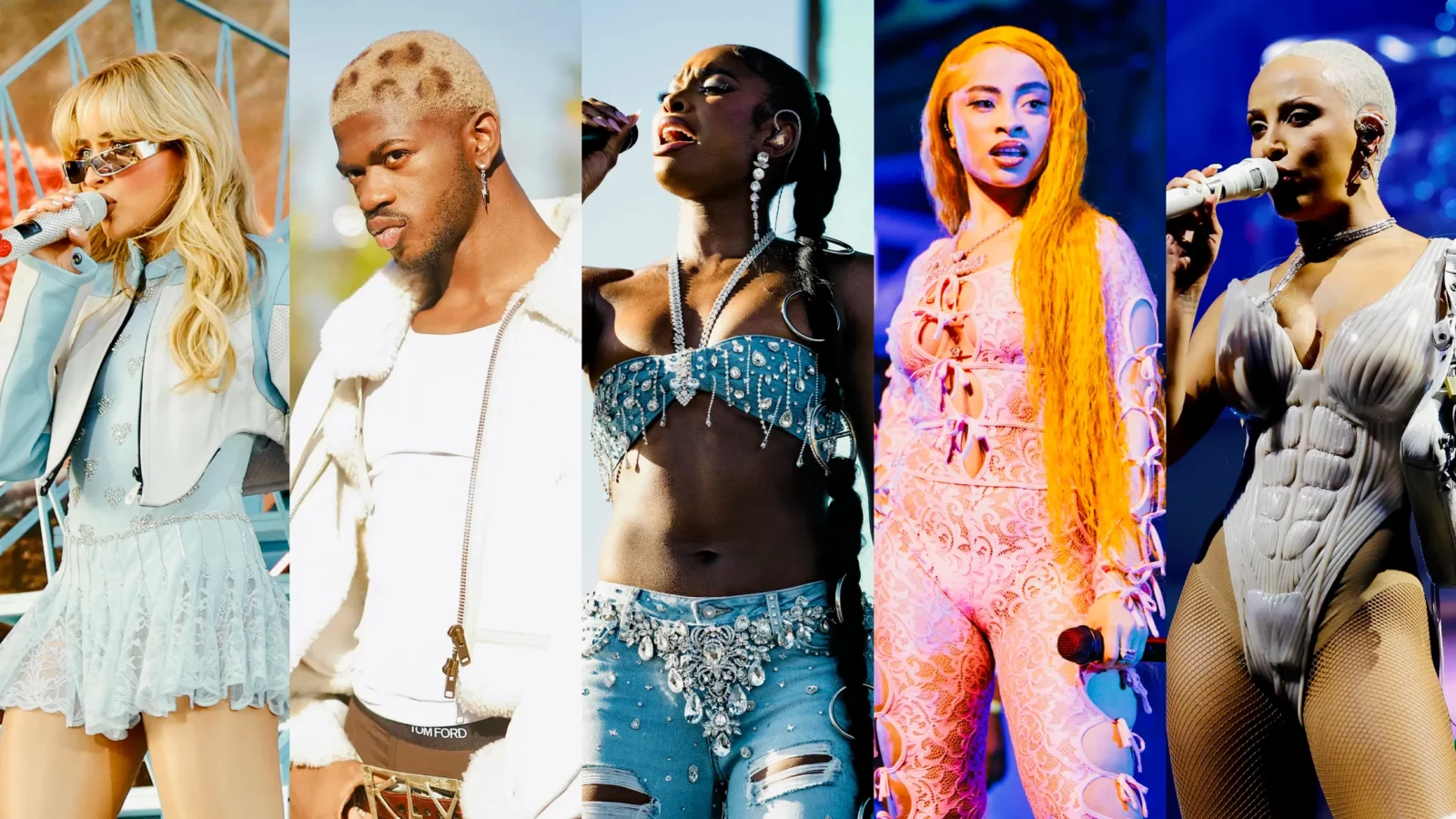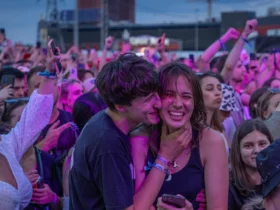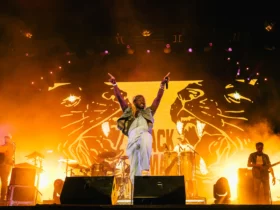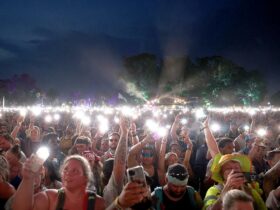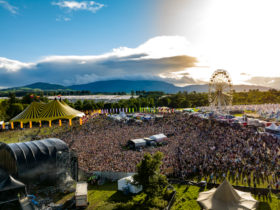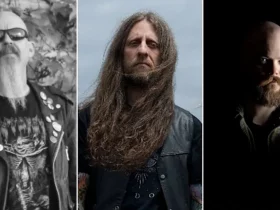Toward the end of No Doubt’s Saturday night performance on Coachella’s main stage—a set surrounded by rumors of the astronomical fee the long-disbanded group must have commanded for their one-off gigs—Gwen Stefani uttered the night’s lone detectable lie. After knocking out 10 quick push-ups, and before launching into “Just a Girl,” the 54-year-old Orange County native remarked, “We are absolutely in the future right now.” A nice thought, perhaps, but tough to reconcile with the wave of nostalgia that defined their set, the rest of Saturday’s lineup, and post-COVID Coachella as a whole.
Earlier this spring, the press highlighted the festival’s slower-than-usual ticket sales. Typically, the first weekend sells out within hours of wristbands becoming available, even before the lineup is announced; this year, it took almost a month. Billboard reported last week that only about 80 percent of the 250,000 tickets available across both weekends of Coachella had been sold.
With that in mind, Coachella staked this year’s lineup on a certain longing for the past. The festival has, of course, welcomed AC/DC and Guns N’ Roses as headliners before, but those bands evoked the past by blasting it in the crowd’s face. No Doubt, in contrast, went for sentimentality, playing soft-focus footage of their early days as they performed onstage. And Billie Eilish, in a surprise DJ set on Saturday night at the Do Lab stage, spun some late-2000s/early-2010s pop hits. Performances like these might become suffocating, especially when scheduled close to one another, but they didn’t necessarily scan as regressive. As ubiquitous as “Don’t Speak” or Tyga’s “Rack City” were when they were released, they still sound odder, more alluringly alien than much of the music emanating from the big stages.
At times, this celebration of the recent past turned uncanny. Sublime’s late-afternoon set on Saturday’s main stage was well-attended, and the band sounded sharp and engaged. But Sublime’s music is an odd vessel for Jakob Nowell, who took over as frontman for his late father, Bradley. If Jakob, Bud Gaugh, and Eric Wilson find their shows together meaningful, or even simply fun, I sincerely hope they continue to play together. But the group’s music functions best when it has stamped out any lingering sense of self-consciousness, an inherently impossible atmosphere to maintain when Jakob Nowell ad-libs, “I love this part,” before he sings the end of “April 29th, 1992 (Miami).” I found it difficult to watch the set without thinking of death—but I’m just one Californian among many.
Maybe, a cynical observer would say, Coachella 2024 also proved that the future might not have much to offer. If you followed the festival online, you’re aware that Grimes’ Saturday evening DJ set in the yawning Sahara tent went less than smoothly. It would, in fact, be difficult to communicate to anyone who wasn’t there what an utter disaster it was: The music kept lurching to a halt, with Grimes going on extended rants about how the people to whom she’d outsourced all her prep work had not properly prepared her tracks. (“This actually isn’t my fault,” she said at one point.) The third or fourth time she complained about the displayed BPMs being incorrect, she warned the crowd that she would have to simply listen to tracks as they played and try to match them with others in real time—prompting the woman beside me to say, “Yeah, that’s DJing.”
Sahara has become a major venue for the festival, often drawing more people than the Outdoor stage, which is a stone’s throw from the main stage and traditionally Coachella’s second-most prestigious spot. By contrast, Sahara is nearly as far away from the main stage as you can get while remaining on the grounds. This year continued a slightly frustrating trend where hip-hop seems to be cordoned away from the nerve center: Sahara had emerging stars Ice Spice and Ken Carson, underground veteran Bones, and major-label also-ran Nav, while Kevin Abstract and Lil Yachty played the nearby Mojave tent.
There is an obvious appetite for rap at Coachella—Lupe Fiasco’s Sunday night set at the Heineken House was so popular that fans assembled to peer into the corporate activation from a nearby food plaza, while T-Pain’s Saturday performance on the same stage was so overcrowded that security moved stragglers away from the structure. But the only American rapper to play a sub-headlining set on the main or Outdoor stage was Lil Uzi Vert, who on Friday night ran through cacophonous arrangements of their songs against a backdrop that reached for a punkish edge but wound up somewhere in the middle of a mall.
A little over 24 hours after the Uzi set finished, Tyler, the Creator fitted the same stage with something far more inventive: a recreated national park, complete with an RV from which he exploded into the air to begin his headlining performance. His set had remarkable breadth without ever straining to be definitive; it spanned Tyler’s 15-year career while seeming intuitive and maintaining a sense of momentum. (It was also brightened by guest appearances from Donald Glover, A$AP Rocky, and an especially luminous Charlie Wilson.) Despite starting close to midnight, Tyler left his crowd of tens of thousands more energized than they’d been when he arrived.
While rap seems sidelined, Coachella continues to treat dance music as its spine. In addition to the Do Lab stage (which benefited from an excellent Hudson Mohawke and Nikki Nair set on Sunday night) and the priority placement the genre receives in the Yuma and Sonora tents in particular, this year saw the introduction of the Quasar stage, an open-air venue set between Sahara and the middle of the grounds. Its Friday christening was capped off by hours of work from Honey Dijon, and, on Sunday, with an hours-long set from Jamie xx, Floating Points, and Daphni, it offered one of the most immersive and inventive experiences of the weekend.
Though increasingly given over to spectacle, one of Coachella’s great joys is the density of expert, unfussy sets by some of the most interesting performers in the world. When planning my Friday itinerary I had somehow overlooked Tinashe’s booking at the Mojave; stumbling onto it by accident, I was captivated. I could report similar experiences from Hermanos Gutiérrez on Sunday in the Sonora tent, Mandy, Indiana at the same, Brittany Howard at Gobi on Friday, or Blxst on the Outdoor stage Saturday evening—the ideally breezy act for that venue.
Coachella’s global popularity as a set of live-streamed performances has further incentivized acts to bring out surprise guests as a strategy to cut through the din, both in the desert and online. On Saturday, Vampire Weekend pushed this to an absolutely excruciating degree, inviting Paris Hilton and then an Abraham Lincoln impersonator onto the Outdoor stage to play cornhole—affected twee colliding with affected folksiness to create something truly grotesque. But the practice also creates genuine excitement for young fans: take the girl beside me at Lil Yachty’s set on Sunday night, who at the first, barely-audible syllable of a new vocalist screamed, “IS THAT FUCKING MAC DEMARCO?” Reader, it was.
Be it out of necessity for those live streams or simply because technology marches forward, we are living in a golden age of video and stage design. On the main stage Sunday night, J Balvin took pains to communicate his superstardom, changing between a half-dozen equally extravagant outfits and utilizing constantly shifting camera setups. At one point, he stood in the center of a circle of men, each of whom was outfitted with a lens on his head, and bounced from one to the other, rapping into a series of fish-eye views, as if caught in one of Kool Keith’s dreams. (The set-spanning alien motif paid out like a rigged slot machine when Will Smith appeared in full Men in Black to perform his song from the soundtrack.) In the same place the night before, Blur’s excellent set was backed by eerie real-time surveillance footage of Damon Albarn and the band—which, when the setlist got to sporting-event staple “Song 2,” shifted to a feed of empty stadiums. A lone lawn mower drifting across a soccer pitch, women sweeping the edges of a basketball court, energy implied but never explicated.
At the weekend’s very end, though, this element became oddly depersonalizing. Doja Cat’s headlining set was thoroughly choreographed and executed with precision—but seemed tailored for the audience at home. The visual language became that of an awards show performance, with low-angle shots from the stage interspersed with drone shots showing the expanse of the crowd. Doja barely spoke to the audience; in the set’s final third, each song was separated by a dark stage and dead air, not quite long enough to signal a break between the set proper and an encore, but long enough to make the crowd wonder, every three or four minutes, if that’s what was happening.
The Friday night headliner, Lana Del Rey, was in stark contrast to Doja Cat, though not always for the better. Her set was hampered by poor sound in her microphone, presumably due to the high winds at that time. Because of that, it never quite achieved the hermetic quality that benefits Del Rey’s music—the sense that all of history, American and her own, is happening at once, violently but slowly. Instead, this illusion was punctured, replaced by a smaller, concentric circle of history, one that only looped as far back as the beginning of her career, including her maligned 2012 Saturday Night Live performance. It was frequently engrossing and, as could be expected, a pointed comment on how celebrity corrodes. But unlike in her recorded music, it was complicated by the unshakeable sense that it was missing something that can never be recaptured, no matter how well we think we remember.
